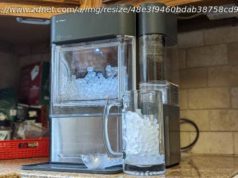A student at Monday’s TC Sessions: Robotics event in Cambridge asked me “How do I launch a successful startup?” I explained that I might not be the..
You are about to activate our Facebook Messenger news bot. Once subscribed, the bot will send you a digest of trending stories once a day. You can also customize the types of stories it sends you.
Click on the button below to subscribe and wait for a new Facebook message from the TC Messenger news bot.
Thanks,
TC Team
Coverage Sponsors Agenda Participants More Event Info More Event Info Video Robotics
Sami Atiya from ABB says industrial robots will add jobs, not take them away
Watch all of the panels from TC Sessions: Robotics right here
Anti-drone radio wave startup SkySafe secures $11.5M from Andreessen
Browse more…
Browse more… TechCrunch Sessions: Robotics
This ‘shape-display’ robot follows your hand and simulates the surface you’ re touching in VR
Browse more…
Browse more… tc sessions robotics 2017
Sami Atiya from ABB says industrial robots will add jobs, not take them away
Watch all of the panels from TC Sessions: Robotics right here
ReWalk Robotics shows off a soft exosuit designed to bring mobility to stroke patients
Browse more…
Browse more… tc sessions robotics
Watch all of the panels from TC Sessions: Robotics right here
Franklin Robotics’ Tertill wins the pitch-off at TC Sessions: Robotics
ReWalk Robotics shows off a soft exosuit designed to bring mobility to stroke patients
Browse more…
Browse more… tc sessions
Watch all of the panels from TC Sessions: Robotics right here
Browse more…
Browse more… Brian Heater @bheater 0 SHARES
Next Story
Watch the first trailer for Steven Spielberg’s adaptation of ‘Ready Player One’
Advertisement
A student walked up to me at an event following Monday’s TC Sessions: Robotics event in Cambridge. “I have a question for you, ” he said, adding that he was a few months away from becoming a college senior. “How do I launch a successful startup?”
A student walked up to me at an event following Monday’s TC Sessions: Robotics event in Cambridge. “I have a question for you, ” he said, adding that he was a few months away from becoming a college senior. “How do I launch a successful startup?” Monday’s TC Sessions: Robotics
I explained that I might not be the person at the show best equipped to answer, but I offered some simple advice nonetheless: find a problem that needs solving, address a need that already exists, and don’ t go offering up solutions in search of problems.
Oh, and get a day job.
Learn the industry and the ins and outs of running a business from someone who’s already in it. Work on your passion on the weekends and after work, while you’ re young and still have the energy to invest. Be bold and be excited, but temper that with pragmatism. There’s a reason that one of the most successful robotics companies at the event is the one that sells robotic vacuums. It’s not universal advise, but it’s a model that’s worked for countless startups before.
The student seemed unimpressed.
It wasn’ t difficult to come up with an answer. It was something I’ d been thinking about quite a bit in the lead up to the event. Moderating multiple panels gave me the opportunity to put the questions to a number of people far smarter and with far more direct industry experience. It was the one question I had on my index cards for multiple conversations: “Are universities doing a good enough job preparing students to make the jump from the research lab to real-world commercial endeavors?”
“At MIT, we’ re very excited about taking ideas that matter today and making them real, ” Daniela Rus, the head of MIT’s massive CSAIL interdisciplinary laboratory told me toward the close of the day’s first panel. “In general, we are focused on long-term research. We want to invest in the future of computing and a future enabled by computing. But we are also very interested in how our ideas can matter today.” Daniela Rus
Universities and startups are very different beasts, built around very different models. Schools have their own pressures — getting grants/sponsorships, publishing papers, applying for awards. But any researcher interviewed about their work by a member of the media will invariably get the same question: what are the commercial applications for this work? That topic isn’ t always at the top of students’ and professors’ minds when they’ re doing the sort of “long-term research” to which Rus refers.
But there does seem to be an increasing interest in helping researchers make the transition to real-world product. Certainly there’s a lot to be said for seeing the work on which you’ ve spent months or years laboring have a direct impact on the lives of real people. Earlier this week, I spoke to ReWalk Robotics CEO Larry Jasinski about the company’s relationship with Harvard’s Wyss Institute. ReWalk Robotics CEO Larry Jasinski
Turning research into product is one of the institute’s key components, working to “leverage [its] internal business development team, intellectual property experts, and entrepreneurs-in-residence to drive commercialization, through industrial partnerships and the creation of startups, ” according to its mission statement.
In the case of ReWalk, the company gets to commercialize the research of Biodesign Lab head Conor Walsh, in exchange for help with FCC red tape, market considerations and royalties on sales. “They’ re trying to develop the institute as something that has more of an application mindset, ” Jasinski told me. “We are a bit of an experiment, as part of their attempted business model.” Conor Walsh
It’s a commendable model, particularly in the case of the Restore soft exosuit the partnership has created to assist stroke patients. But that particular model doesn’ t address those students looking to transition out of the research lab and into the world of commercial robotics.
In a conversation with our own Ron Miller, Sami Atiya, the president of Robotics and Motion at industrial automation giant ABB, did a good job succinctly contrasting the two worlds. “In academia, we focus on proving a hypothesis works, ” he explained. “If you look at the industry, if we did that, we wouldn’ t be able to survive. We have to feed solutions to our customers that are highly repetitive, precise and accurate. The customer wants to have 99 percent uptime that is repeatable, at a cost that is affordable.”
Expectations shift dramatically when research becomes product. No one knows this better than iRobot CEO Colin Angle. The company’s first dozen years were a struggle to create a truly profitable robotics company. It’s a decade lined with space rovers, baby dolls and movie licensing attempts before finally creating the Roomba in 2002, a product that has disrupted the vacuum industry and become the first — and arguably still only — mainstream home robot. iRobot CEO Colin Angle
Angle laughingly explains that he didn’ t find success as a roboticist until he became a “vacuum salesman.” It’s a funny statement, but the sentiment is important. The key to launching a successful robotics startup is focusing on the practical ways in which technology can positively augment our lives — and, to some degree, getting lucky.
“The idea that you launch with, you’ ll either be very, very lucky or wrong, ” Angle told me during our interview. “You’ ll need to stay open to learning how the rest of the world reacts to your idea and be flexible. Patience is also critically important, and it’s best not to do it alone. At iRobot, if we had been alone, instead of the three of us, it would have been a very different experience.
Home
United States
USA — software Helping students transition from the laboratory to robotics startup






